Risk Management Strategies: A Case Study on Samsung Galaxy Note 7
VerifiedAdded on 2023/06/07
|9
|2576
|299
AI Summary
This report delves into the risk management strategies used by Samsung for their Galaxy Note 7 products. It evaluates the case study on the basis of risk assessment, consequences, impact, and more.
Contribute Materials
Your contribution can guide someone’s learning journey. Share your
documents today.

Individual Report
Secure Best Marks with AI Grader
Need help grading? Try our AI Grader for instant feedback on your assignments.
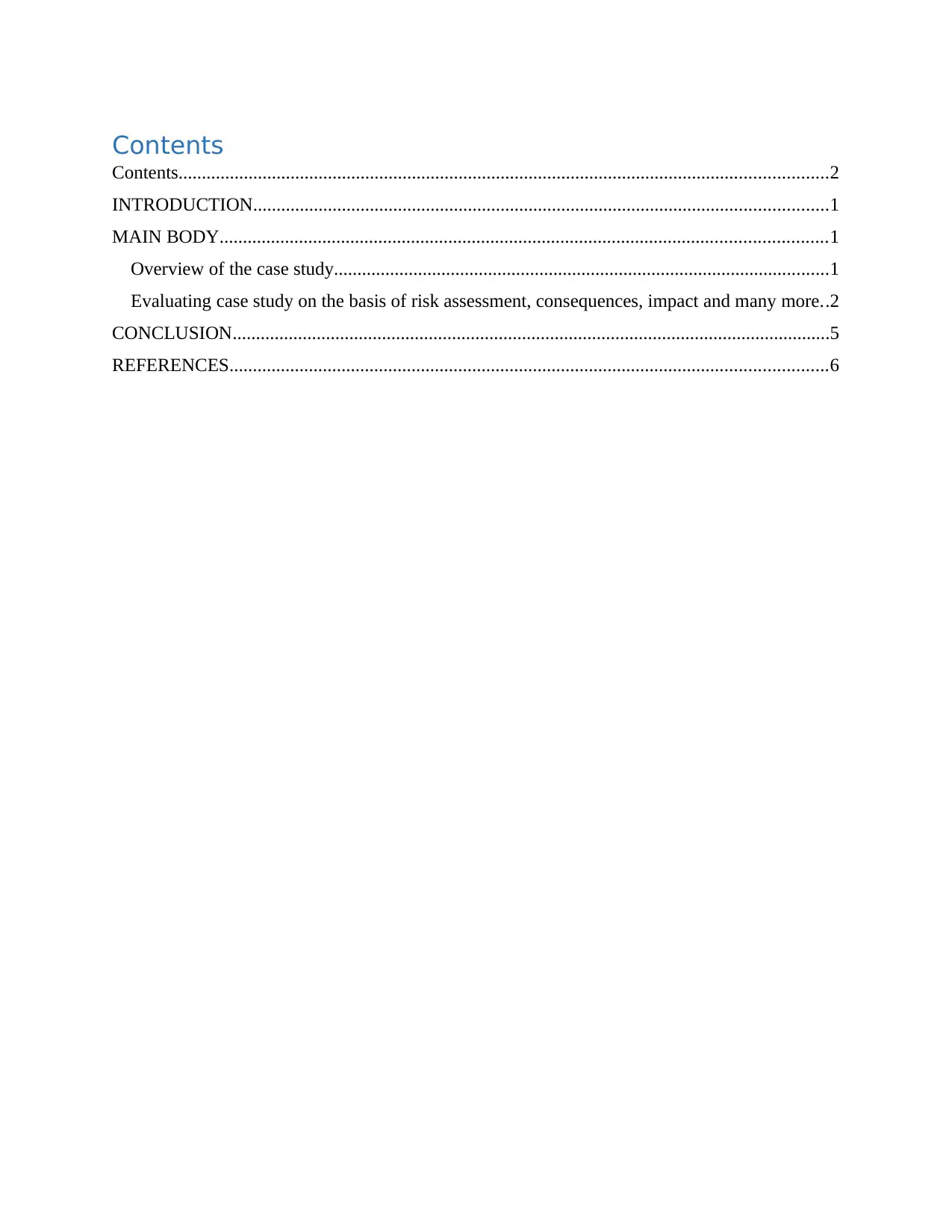
Contents
Contents...........................................................................................................................................2
INTRODUCTION...........................................................................................................................1
MAIN BODY..................................................................................................................................1
Overview of the case study..........................................................................................................1
Evaluating case study on the basis of risk assessment, consequences, impact and many more..2
CONCLUSION................................................................................................................................5
REFERENCES................................................................................................................................6
Contents...........................................................................................................................................2
INTRODUCTION...........................................................................................................................1
MAIN BODY..................................................................................................................................1
Overview of the case study..........................................................................................................1
Evaluating case study on the basis of risk assessment, consequences, impact and many more..2
CONCLUSION................................................................................................................................5
REFERENCES................................................................................................................................6
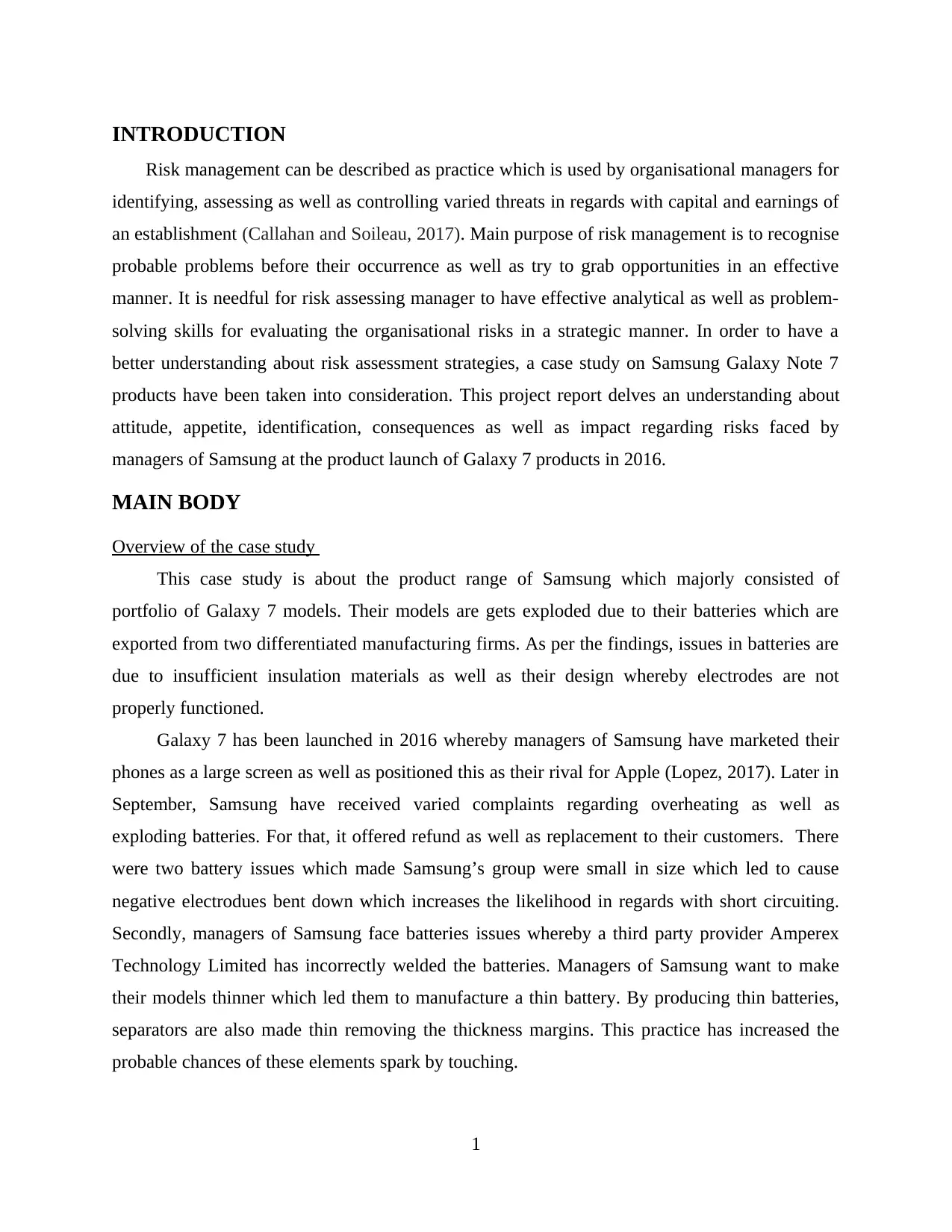
INTRODUCTION
Risk management can be described as practice which is used by organisational managers for
identifying, assessing as well as controlling varied threats in regards with capital and earnings of
an establishment (Callahan and Soileau, 2017). Main purpose of risk management is to recognise
probable problems before their occurrence as well as try to grab opportunities in an effective
manner. It is needful for risk assessing manager to have effective analytical as well as problem-
solving skills for evaluating the organisational risks in a strategic manner. In order to have a
better understanding about risk assessment strategies, a case study on Samsung Galaxy Note 7
products have been taken into consideration. This project report delves an understanding about
attitude, appetite, identification, consequences as well as impact regarding risks faced by
managers of Samsung at the product launch of Galaxy 7 products in 2016.
MAIN BODY
Overview of the case study
This case study is about the product range of Samsung which majorly consisted of
portfolio of Galaxy 7 models. Their models are gets exploded due to their batteries which are
exported from two differentiated manufacturing firms. As per the findings, issues in batteries are
due to insufficient insulation materials as well as their design whereby electrodes are not
properly functioned.
Galaxy 7 has been launched in 2016 whereby managers of Samsung have marketed their
phones as a large screen as well as positioned this as their rival for Apple (Lopez, 2017). Later in
September, Samsung have received varied complaints regarding overheating as well as
exploding batteries. For that, it offered refund as well as replacement to their customers. There
were two battery issues which made Samsung’s group were small in size which led to cause
negative electrodues bent down which increases the likelihood in regards with short circuiting.
Secondly, managers of Samsung face batteries issues whereby a third party provider Amperex
Technology Limited has incorrectly welded the batteries. Managers of Samsung want to make
their models thinner which led them to manufacture a thin battery. By producing thin batteries,
separators are also made thin removing the thickness margins. This practice has increased the
probable chances of these elements spark by touching.
1
Risk management can be described as practice which is used by organisational managers for
identifying, assessing as well as controlling varied threats in regards with capital and earnings of
an establishment (Callahan and Soileau, 2017). Main purpose of risk management is to recognise
probable problems before their occurrence as well as try to grab opportunities in an effective
manner. It is needful for risk assessing manager to have effective analytical as well as problem-
solving skills for evaluating the organisational risks in a strategic manner. In order to have a
better understanding about risk assessment strategies, a case study on Samsung Galaxy Note 7
products have been taken into consideration. This project report delves an understanding about
attitude, appetite, identification, consequences as well as impact regarding risks faced by
managers of Samsung at the product launch of Galaxy 7 products in 2016.
MAIN BODY
Overview of the case study
This case study is about the product range of Samsung which majorly consisted of
portfolio of Galaxy 7 models. Their models are gets exploded due to their batteries which are
exported from two differentiated manufacturing firms. As per the findings, issues in batteries are
due to insufficient insulation materials as well as their design whereby electrodes are not
properly functioned.
Galaxy 7 has been launched in 2016 whereby managers of Samsung have marketed their
phones as a large screen as well as positioned this as their rival for Apple (Lopez, 2017). Later in
September, Samsung have received varied complaints regarding overheating as well as
exploding batteries. For that, it offered refund as well as replacement to their customers. There
were two battery issues which made Samsung’s group were small in size which led to cause
negative electrodues bent down which increases the likelihood in regards with short circuiting.
Secondly, managers of Samsung face batteries issues whereby a third party provider Amperex
Technology Limited has incorrectly welded the batteries. Managers of Samsung want to make
their models thinner which led them to manufacture a thin battery. By producing thin batteries,
separators are also made thin removing the thickness margins. This practice has increased the
probable chances of these elements spark by touching.
1
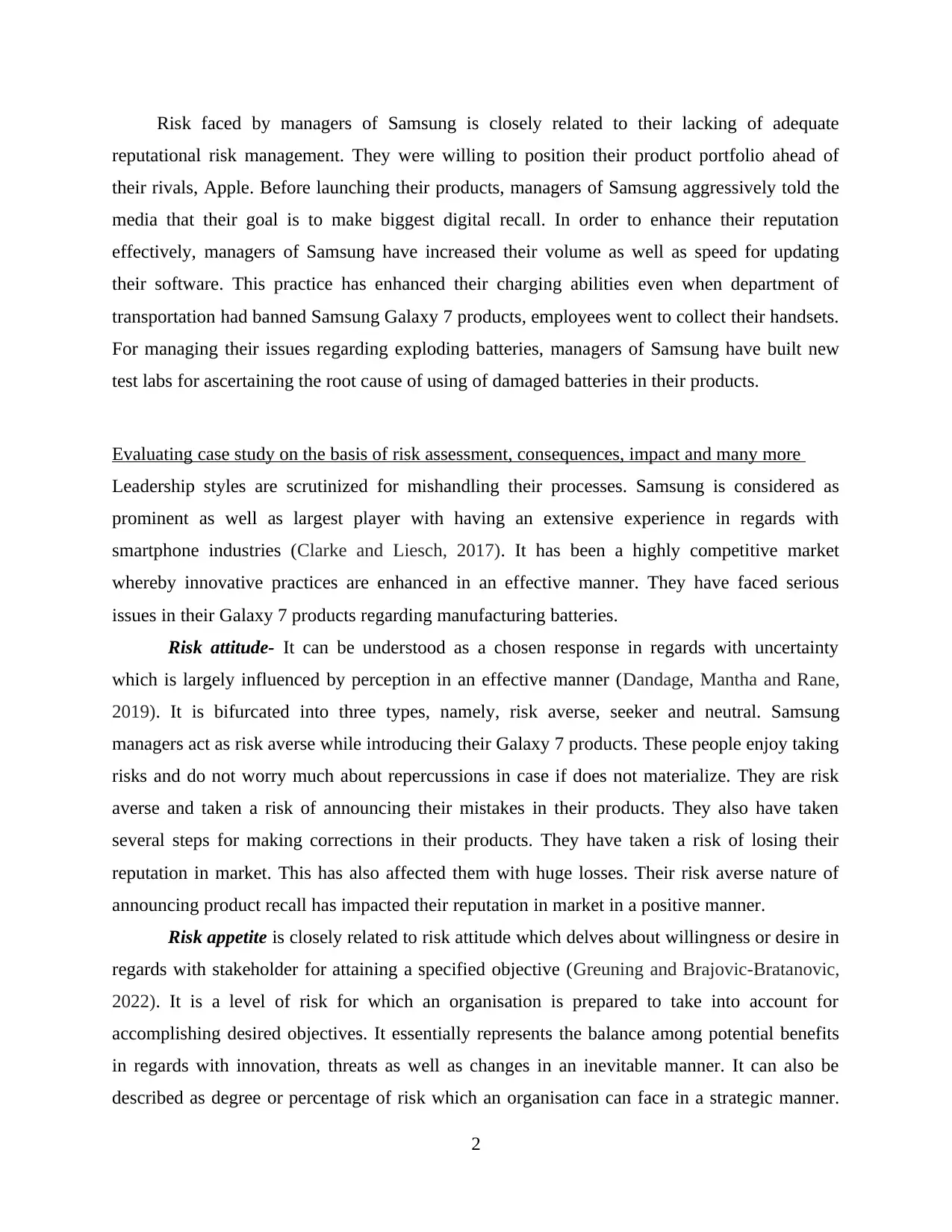
Risk faced by managers of Samsung is closely related to their lacking of adequate
reputational risk management. They were willing to position their product portfolio ahead of
their rivals, Apple. Before launching their products, managers of Samsung aggressively told the
media that their goal is to make biggest digital recall. In order to enhance their reputation
effectively, managers of Samsung have increased their volume as well as speed for updating
their software. This practice has enhanced their charging abilities even when department of
transportation had banned Samsung Galaxy 7 products, employees went to collect their handsets.
For managing their issues regarding exploding batteries, managers of Samsung have built new
test labs for ascertaining the root cause of using of damaged batteries in their products.
Evaluating case study on the basis of risk assessment, consequences, impact and many more
Leadership styles are scrutinized for mishandling their processes. Samsung is considered as
prominent as well as largest player with having an extensive experience in regards with
smartphone industries (Clarke and Liesch, 2017). It has been a highly competitive market
whereby innovative practices are enhanced in an effective manner. They have faced serious
issues in their Galaxy 7 products regarding manufacturing batteries.
Risk attitude- It can be understood as a chosen response in regards with uncertainty
which is largely influenced by perception in an effective manner (Dandage, Mantha and Rane,
2019). It is bifurcated into three types, namely, risk averse, seeker and neutral. Samsung
managers act as risk averse while introducing their Galaxy 7 products. These people enjoy taking
risks and do not worry much about repercussions in case if does not materialize. They are risk
averse and taken a risk of announcing their mistakes in their products. They also have taken
several steps for making corrections in their products. They have taken a risk of losing their
reputation in market. This has also affected them with huge losses. Their risk averse nature of
announcing product recall has impacted their reputation in market in a positive manner.
Risk appetite is closely related to risk attitude which delves about willingness or desire in
regards with stakeholder for attaining a specified objective (Greuning and Brajovic-Bratanovic,
2022). It is a level of risk for which an organisation is prepared to take into account for
accomplishing desired objectives. It essentially represents the balance among potential benefits
in regards with innovation, threats as well as changes in an inevitable manner. It can also be
described as degree or percentage of risk which an organisation can face in a strategic manner.
2
reputational risk management. They were willing to position their product portfolio ahead of
their rivals, Apple. Before launching their products, managers of Samsung aggressively told the
media that their goal is to make biggest digital recall. In order to enhance their reputation
effectively, managers of Samsung have increased their volume as well as speed for updating
their software. This practice has enhanced their charging abilities even when department of
transportation had banned Samsung Galaxy 7 products, employees went to collect their handsets.
For managing their issues regarding exploding batteries, managers of Samsung have built new
test labs for ascertaining the root cause of using of damaged batteries in their products.
Evaluating case study on the basis of risk assessment, consequences, impact and many more
Leadership styles are scrutinized for mishandling their processes. Samsung is considered as
prominent as well as largest player with having an extensive experience in regards with
smartphone industries (Clarke and Liesch, 2017). It has been a highly competitive market
whereby innovative practices are enhanced in an effective manner. They have faced serious
issues in their Galaxy 7 products regarding manufacturing batteries.
Risk attitude- It can be understood as a chosen response in regards with uncertainty
which is largely influenced by perception in an effective manner (Dandage, Mantha and Rane,
2019). It is bifurcated into three types, namely, risk averse, seeker and neutral. Samsung
managers act as risk averse while introducing their Galaxy 7 products. These people enjoy taking
risks and do not worry much about repercussions in case if does not materialize. They are risk
averse and taken a risk of announcing their mistakes in their products. They also have taken
several steps for making corrections in their products. They have taken a risk of losing their
reputation in market. This has also affected them with huge losses. Their risk averse nature of
announcing product recall has impacted their reputation in market in a positive manner.
Risk appetite is closely related to risk attitude which delves about willingness or desire in
regards with stakeholder for attaining a specified objective (Greuning and Brajovic-Bratanovic,
2022). It is a level of risk for which an organisation is prepared to take into account for
accomplishing desired objectives. It essentially represents the balance among potential benefits
in regards with innovation, threats as well as changes in an inevitable manner. It can also be
described as degree or percentage of risk which an organisation can face in a strategic manner.
2
Secure Best Marks with AI Grader
Need help grading? Try our AI Grader for instant feedback on your assignments.

Likewise, managers of Samsung want to accomplish their objectives by making their effective
position in front of their rival company, Apple. For this, they have taken a risk of introducing
their Galaxy 7 product portfolio range. However, their strategy is taken up a down turn where
their products gets exploded due to wrong batteries design. For being a risk appetite company,
they have taken a risk of evaluating software as well as algorithms which are essentially tied to
their wireless charging. They have also ascertained third party applications which can influence
their phones. Managers of Samsung also have assessed the need of product recall which also help
them in bringing innovative practices in an effective manner.
Risk identification- It can be described as a process which is used for determining varied
issues which can probably prevent the task to be completed or attaining organisational objectives
in an effective manner (Hillson, 2017). Main purpose of risk identification is to reveal and assess
the reasons about the capabilities of an establishment in regards with managing the issues. Risk
identification is considered as an important task which is used for creating comprehensive
understanding which can be leveraged for influencing stakeholders for preparing better projects.
Managers of Samsung identified issues in their batteries which were due to negative electrodes
and abnormal ultrasonic welding burrs.
They have recognised that smartphone industry is desiring for thinner headsets which have
longer battery life. This desire had strained the battery manufacturing processes in a significant
manner (Hirsch, 2018). This practice has helped them in adopting a quality assurance process
which has to be followed by Samsung as well as their components manufacturers in an effective
manner.
Risk consequences- It can be explained as possible outcomes in regards with undesired
event or incident which encompasses of loss or damage to the organisational values in a
significant manner (Ivanov, 2018) . It can be estimated by imagining the outcomes in respect to
an undesired event. In regards with Samsung, they have face consequences of failure of their
products Galaxy 7 due to their harmful batteries. This practice has adverse consequences on
them regarding disregarding their reputation in the market. It has also made customers to lose
their trust in the products of Samsung. They have to invest their huge resources in making
modification in lab testing procedures in a strategic manner. However, it has impacted positively
to them as they have developed their lab testing procedures in a significant manner.
3
position in front of their rival company, Apple. For this, they have taken a risk of introducing
their Galaxy 7 product portfolio range. However, their strategy is taken up a down turn where
their products gets exploded due to wrong batteries design. For being a risk appetite company,
they have taken a risk of evaluating software as well as algorithms which are essentially tied to
their wireless charging. They have also ascertained third party applications which can influence
their phones. Managers of Samsung also have assessed the need of product recall which also help
them in bringing innovative practices in an effective manner.
Risk identification- It can be described as a process which is used for determining varied
issues which can probably prevent the task to be completed or attaining organisational objectives
in an effective manner (Hillson, 2017). Main purpose of risk identification is to reveal and assess
the reasons about the capabilities of an establishment in regards with managing the issues. Risk
identification is considered as an important task which is used for creating comprehensive
understanding which can be leveraged for influencing stakeholders for preparing better projects.
Managers of Samsung identified issues in their batteries which were due to negative electrodes
and abnormal ultrasonic welding burrs.
They have recognised that smartphone industry is desiring for thinner headsets which have
longer battery life. This desire had strained the battery manufacturing processes in a significant
manner (Hirsch, 2018). This practice has helped them in adopting a quality assurance process
which has to be followed by Samsung as well as their components manufacturers in an effective
manner.
Risk consequences- It can be explained as possible outcomes in regards with undesired
event or incident which encompasses of loss or damage to the organisational values in a
significant manner (Ivanov, 2018) . It can be estimated by imagining the outcomes in respect to
an undesired event. In regards with Samsung, they have face consequences of failure of their
products Galaxy 7 due to their harmful batteries. This practice has adverse consequences on
them regarding disregarding their reputation in the market. It has also made customers to lose
their trust in the products of Samsung. They have to invest their huge resources in making
modification in lab testing procedures in a strategic manner. However, it has impacted positively
to them as they have developed their lab testing procedures in a significant manner.
3
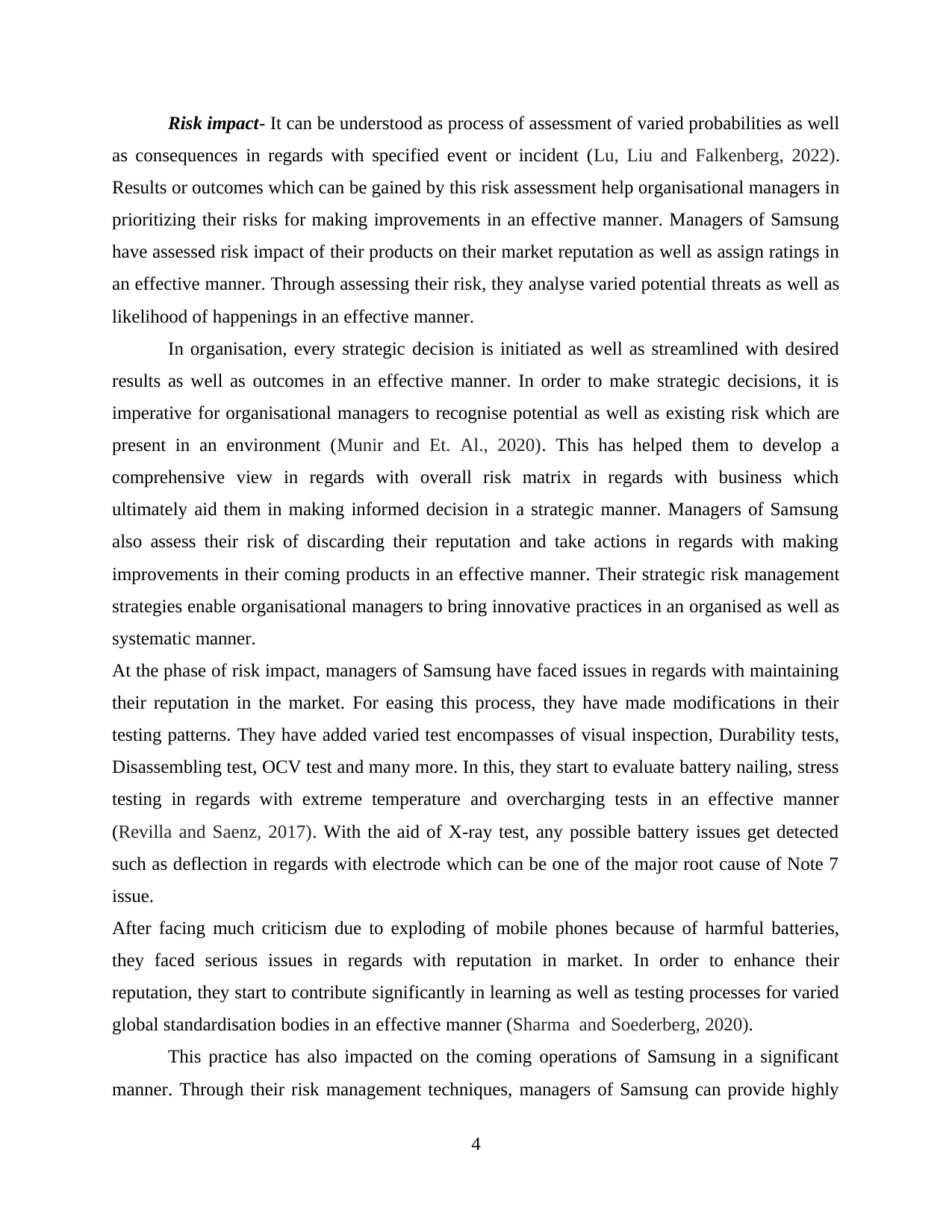
Risk impact- It can be understood as process of assessment of varied probabilities as well
as consequences in regards with specified event or incident (Lu, Liu and Falkenberg, 2022).
Results or outcomes which can be gained by this risk assessment help organisational managers in
prioritizing their risks for making improvements in an effective manner. Managers of Samsung
have assessed risk impact of their products on their market reputation as well as assign ratings in
an effective manner. Through assessing their risk, they analyse varied potential threats as well as
likelihood of happenings in an effective manner.
In organisation, every strategic decision is initiated as well as streamlined with desired
results as well as outcomes in an effective manner. In order to make strategic decisions, it is
imperative for organisational managers to recognise potential as well as existing risk which are
present in an environment (Munir and Et. Al., 2020). This has helped them to develop a
comprehensive view in regards with overall risk matrix in regards with business which
ultimately aid them in making informed decision in a strategic manner. Managers of Samsung
also assess their risk of discarding their reputation and take actions in regards with making
improvements in their coming products in an effective manner. Their strategic risk management
strategies enable organisational managers to bring innovative practices in an organised as well as
systematic manner.
At the phase of risk impact, managers of Samsung have faced issues in regards with maintaining
their reputation in the market. For easing this process, they have made modifications in their
testing patterns. They have added varied test encompasses of visual inspection, Durability tests,
Disassembling test, OCV test and many more. In this, they start to evaluate battery nailing, stress
testing in regards with extreme temperature and overcharging tests in an effective manner
(Revilla and Saenz, 2017). With the aid of X-ray test, any possible battery issues get detected
such as deflection in regards with electrode which can be one of the major root cause of Note 7
issue.
After facing much criticism due to exploding of mobile phones because of harmful batteries,
they faced serious issues in regards with reputation in market. In order to enhance their
reputation, they start to contribute significantly in learning as well as testing processes for varied
global standardisation bodies in an effective manner (Sharma and Soederberg, 2020).
This practice has also impacted on the coming operations of Samsung in a significant
manner. Through their risk management techniques, managers of Samsung can provide highly
4
as consequences in regards with specified event or incident (Lu, Liu and Falkenberg, 2022).
Results or outcomes which can be gained by this risk assessment help organisational managers in
prioritizing their risks for making improvements in an effective manner. Managers of Samsung
have assessed risk impact of their products on their market reputation as well as assign ratings in
an effective manner. Through assessing their risk, they analyse varied potential threats as well as
likelihood of happenings in an effective manner.
In organisation, every strategic decision is initiated as well as streamlined with desired
results as well as outcomes in an effective manner. In order to make strategic decisions, it is
imperative for organisational managers to recognise potential as well as existing risk which are
present in an environment (Munir and Et. Al., 2020). This has helped them to develop a
comprehensive view in regards with overall risk matrix in regards with business which
ultimately aid them in making informed decision in a strategic manner. Managers of Samsung
also assess their risk of discarding their reputation and take actions in regards with making
improvements in their coming products in an effective manner. Their strategic risk management
strategies enable organisational managers to bring innovative practices in an organised as well as
systematic manner.
At the phase of risk impact, managers of Samsung have faced issues in regards with maintaining
their reputation in the market. For easing this process, they have made modifications in their
testing patterns. They have added varied test encompasses of visual inspection, Durability tests,
Disassembling test, OCV test and many more. In this, they start to evaluate battery nailing, stress
testing in regards with extreme temperature and overcharging tests in an effective manner
(Revilla and Saenz, 2017). With the aid of X-ray test, any possible battery issues get detected
such as deflection in regards with electrode which can be one of the major root cause of Note 7
issue.
After facing much criticism due to exploding of mobile phones because of harmful batteries,
they faced serious issues in regards with reputation in market. In order to enhance their
reputation, they start to contribute significantly in learning as well as testing processes for varied
global standardisation bodies in an effective manner (Sharma and Soederberg, 2020).
This practice has also impacted on the coming operations of Samsung in a significant
manner. Through their risk management techniques, managers of Samsung can provide highly
4
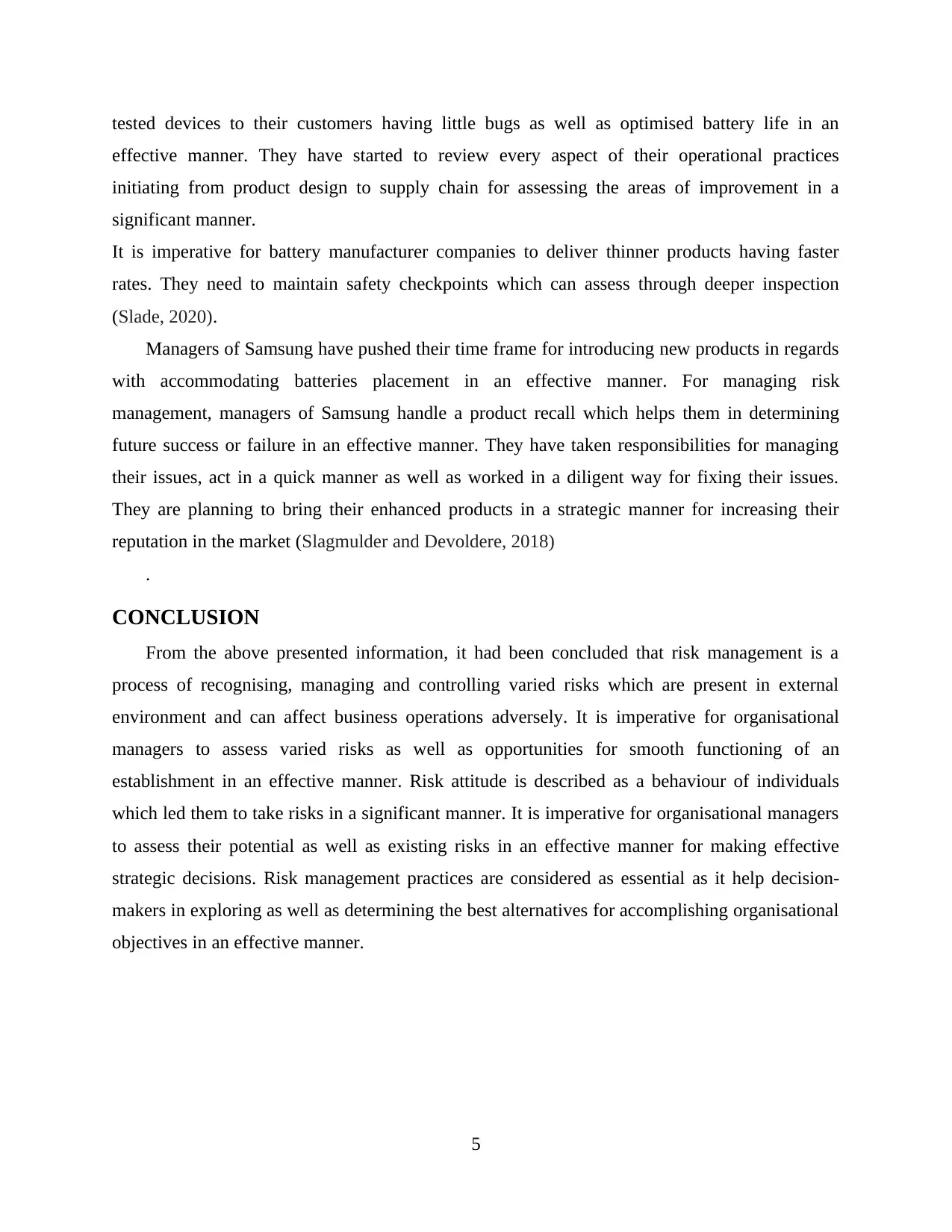
tested devices to their customers having little bugs as well as optimised battery life in an
effective manner. They have started to review every aspect of their operational practices
initiating from product design to supply chain for assessing the areas of improvement in a
significant manner.
It is imperative for battery manufacturer companies to deliver thinner products having faster
rates. They need to maintain safety checkpoints which can assess through deeper inspection
(Slade, 2020).
Managers of Samsung have pushed their time frame for introducing new products in regards
with accommodating batteries placement in an effective manner. For managing risk
management, managers of Samsung handle a product recall which helps them in determining
future success or failure in an effective manner. They have taken responsibilities for managing
their issues, act in a quick manner as well as worked in a diligent way for fixing their issues.
They are planning to bring their enhanced products in a strategic manner for increasing their
reputation in the market (Slagmulder and Devoldere, 2018)
.
CONCLUSION
From the above presented information, it had been concluded that risk management is a
process of recognising, managing and controlling varied risks which are present in external
environment and can affect business operations adversely. It is imperative for organisational
managers to assess varied risks as well as opportunities for smooth functioning of an
establishment in an effective manner. Risk attitude is described as a behaviour of individuals
which led them to take risks in a significant manner. It is imperative for organisational managers
to assess their potential as well as existing risks in an effective manner for making effective
strategic decisions. Risk management practices are considered as essential as it help decision-
makers in exploring as well as determining the best alternatives for accomplishing organisational
objectives in an effective manner.
5
effective manner. They have started to review every aspect of their operational practices
initiating from product design to supply chain for assessing the areas of improvement in a
significant manner.
It is imperative for battery manufacturer companies to deliver thinner products having faster
rates. They need to maintain safety checkpoints which can assess through deeper inspection
(Slade, 2020).
Managers of Samsung have pushed their time frame for introducing new products in regards
with accommodating batteries placement in an effective manner. For managing risk
management, managers of Samsung handle a product recall which helps them in determining
future success or failure in an effective manner. They have taken responsibilities for managing
their issues, act in a quick manner as well as worked in a diligent way for fixing their issues.
They are planning to bring their enhanced products in a strategic manner for increasing their
reputation in the market (Slagmulder and Devoldere, 2018)
.
CONCLUSION
From the above presented information, it had been concluded that risk management is a
process of recognising, managing and controlling varied risks which are present in external
environment and can affect business operations adversely. It is imperative for organisational
managers to assess varied risks as well as opportunities for smooth functioning of an
establishment in an effective manner. Risk attitude is described as a behaviour of individuals
which led them to take risks in a significant manner. It is imperative for organisational managers
to assess their potential as well as existing risks in an effective manner for making effective
strategic decisions. Risk management practices are considered as essential as it help decision-
makers in exploring as well as determining the best alternatives for accomplishing organisational
objectives in an effective manner.
5
Paraphrase This Document
Need a fresh take? Get an instant paraphrase of this document with our AI Paraphraser
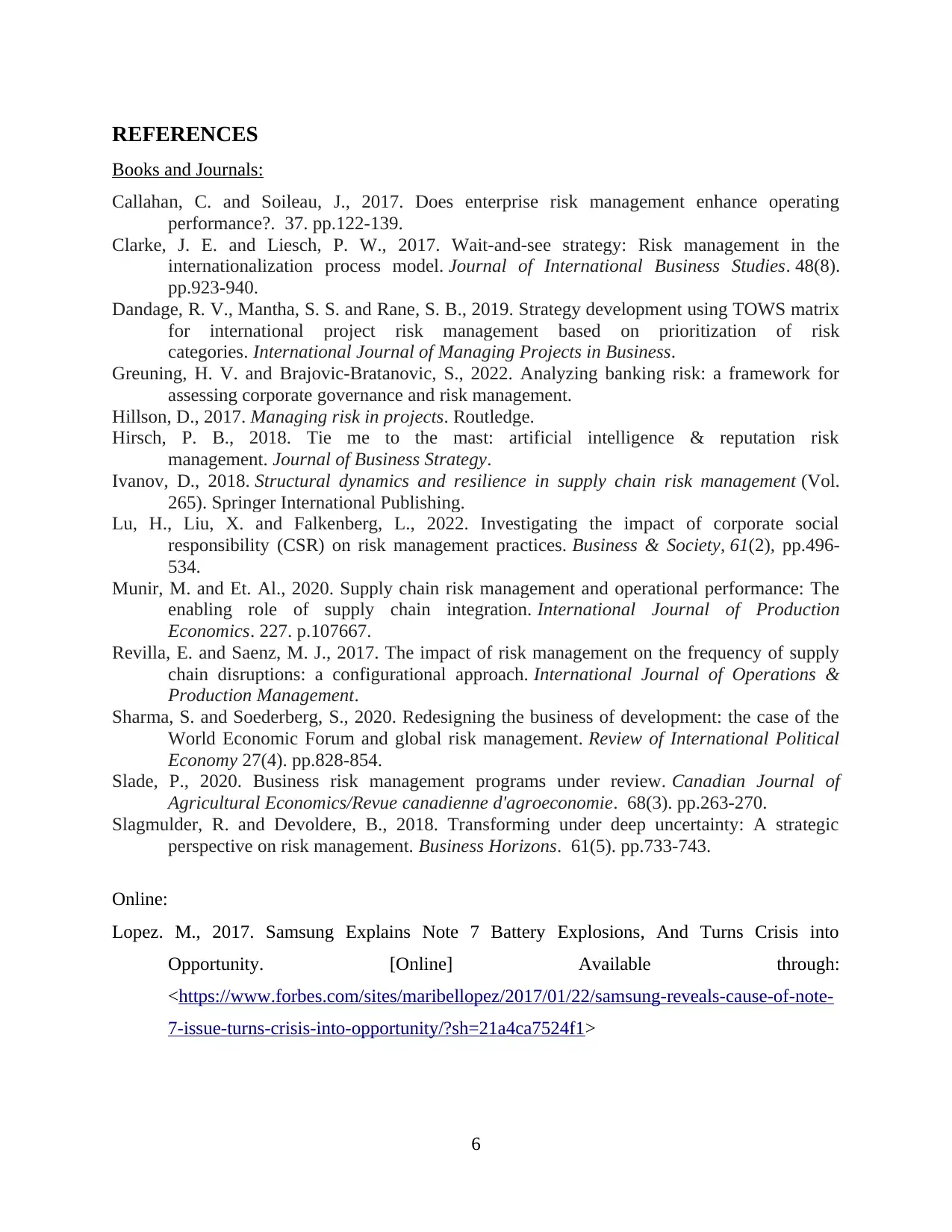
REFERENCES
Books and Journals:
Callahan, C. and Soileau, J., 2017. Does enterprise risk management enhance operating
performance?. 37. pp.122-139.
Clarke, J. E. and Liesch, P. W., 2017. Wait-and-see strategy: Risk management in the
internationalization process model. Journal of International Business Studies. 48(8).
pp.923-940.
Dandage, R. V., Mantha, S. S. and Rane, S. B., 2019. Strategy development using TOWS matrix
for international project risk management based on prioritization of risk
categories. International Journal of Managing Projects in Business.
Greuning, H. V. and Brajovic-Bratanovic, S., 2022. Analyzing banking risk: a framework for
assessing corporate governance and risk management.
Hillson, D., 2017. Managing risk in projects. Routledge.
Hirsch, P. B., 2018. Tie me to the mast: artificial intelligence & reputation risk
management. Journal of Business Strategy.
Ivanov, D., 2018. Structural dynamics and resilience in supply chain risk management (Vol.
265). Springer International Publishing.
Lu, H., Liu, X. and Falkenberg, L., 2022. Investigating the impact of corporate social
responsibility (CSR) on risk management practices. Business & Society, 61(2), pp.496-
534.
Munir, M. and Et. Al., 2020. Supply chain risk management and operational performance: The
enabling role of supply chain integration. International Journal of Production
Economics. 227. p.107667.
Revilla, E. and Saenz, M. J., 2017. The impact of risk management on the frequency of supply
chain disruptions: a configurational approach. International Journal of Operations &
Production Management.
Sharma, S. and Soederberg, S., 2020. Redesigning the business of development: the case of the
World Economic Forum and global risk management. Review of International Political
Economy 27(4). pp.828-854.
Slade, P., 2020. Business risk management programs under review. Canadian Journal of
Agricultural Economics/Revue canadienne d'agroeconomie. 68(3). pp.263-270.
Slagmulder, R. and Devoldere, B., 2018. Transforming under deep uncertainty: A strategic
perspective on risk management. Business Horizons. 61(5). pp.733-743.
Online:
Lopez. M., 2017. Samsung Explains Note 7 Battery Explosions, And Turns Crisis into
Opportunity. [Online] Available through:
<https://www.forbes.com/sites/maribellopez/2017/01/22/samsung-reveals-cause-of-note-
7-issue-turns-crisis-into-opportunity/?sh=21a4ca7524f1>
6
Books and Journals:
Callahan, C. and Soileau, J., 2017. Does enterprise risk management enhance operating
performance?. 37. pp.122-139.
Clarke, J. E. and Liesch, P. W., 2017. Wait-and-see strategy: Risk management in the
internationalization process model. Journal of International Business Studies. 48(8).
pp.923-940.
Dandage, R. V., Mantha, S. S. and Rane, S. B., 2019. Strategy development using TOWS matrix
for international project risk management based on prioritization of risk
categories. International Journal of Managing Projects in Business.
Greuning, H. V. and Brajovic-Bratanovic, S., 2022. Analyzing banking risk: a framework for
assessing corporate governance and risk management.
Hillson, D., 2017. Managing risk in projects. Routledge.
Hirsch, P. B., 2018. Tie me to the mast: artificial intelligence & reputation risk
management. Journal of Business Strategy.
Ivanov, D., 2018. Structural dynamics and resilience in supply chain risk management (Vol.
265). Springer International Publishing.
Lu, H., Liu, X. and Falkenberg, L., 2022. Investigating the impact of corporate social
responsibility (CSR) on risk management practices. Business & Society, 61(2), pp.496-
534.
Munir, M. and Et. Al., 2020. Supply chain risk management and operational performance: The
enabling role of supply chain integration. International Journal of Production
Economics. 227. p.107667.
Revilla, E. and Saenz, M. J., 2017. The impact of risk management on the frequency of supply
chain disruptions: a configurational approach. International Journal of Operations &
Production Management.
Sharma, S. and Soederberg, S., 2020. Redesigning the business of development: the case of the
World Economic Forum and global risk management. Review of International Political
Economy 27(4). pp.828-854.
Slade, P., 2020. Business risk management programs under review. Canadian Journal of
Agricultural Economics/Revue canadienne d'agroeconomie. 68(3). pp.263-270.
Slagmulder, R. and Devoldere, B., 2018. Transforming under deep uncertainty: A strategic
perspective on risk management. Business Horizons. 61(5). pp.733-743.
Online:
Lopez. M., 2017. Samsung Explains Note 7 Battery Explosions, And Turns Crisis into
Opportunity. [Online] Available through:
<https://www.forbes.com/sites/maribellopez/2017/01/22/samsung-reveals-cause-of-note-
7-issue-turns-crisis-into-opportunity/?sh=21a4ca7524f1>
6

7
1 out of 9
Related Documents
Your All-in-One AI-Powered Toolkit for Academic Success.
+13062052269
info@desklib.com
Available 24*7 on WhatsApp / Email
![[object Object]](/_next/static/media/star-bottom.7253800d.svg)
Unlock your academic potential
© 2024 | Zucol Services PVT LTD | All rights reserved.





